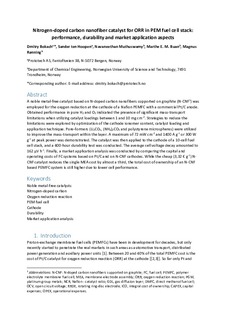| dc.contributor.author | Bokach, Dmitry | |
| dc.contributor.author | ten Hoopen, Sander | |
| dc.contributor.author | Muthuswamy, Navaneethan | |
| dc.contributor.author | Buan, Marthe Emelie Melandsø | |
| dc.contributor.author | Rønning, Magnus | |
| dc.date.accessioned | 2017-10-10T08:10:03Z | |
| dc.date.available | 2017-10-10T08:10:03Z | |
| dc.date.created | 2016-11-16T23:56:50Z | |
| dc.date.issued | 2016 | |
| dc.identifier.citation | International journal of hydrogen energy. 2016, 41 (39), 17616-17630. | nb_NO |
| dc.identifier.issn | 0360-3199 | |
| dc.identifier.uri | http://hdl.handle.net/11250/2459338 | |
| dc.description.abstract | A noble metal-free catalyst based on N-doped carbon nanofibers supported on graphite (N-CNF1 ) was employed for the oxygen reduction at the cathode of a Nafion PEMFC with a commercial Pt/C anode. Obtained performance in pure H2 and O2 indicated the presence of significant mass-transport limitations when utilizing catalyst loadings between 1 and 10 mg cm-2 . Strategies to reduce the limitations were explored by optimization of the cathode ionomer content, catalyst loading and application technique. Pore-formers (Li2CO3, (NH4)2CO3 and polystyrene microspheres) were utilized to improve the mass-transport within the layer. A maximum of 72 mW cm-2 and 1400 A g-1 or 300 W g -1 at peak power was demonstrated. The catalyst was then applied to the cathode of a 10-cell fuel cell stack, and a 400-hour durability test was conducted. The average cell voltage decay amounted to 162 µV h -1 . Finally, a market application analysis was conducted by comparing the capital and operating costs of FC systems based on Pt/C and on N-CNF cathodes. While the cheap (3,32 € g-1 ) NCNF catalyst reduces the single MEA cost by almost a third, the total cost of ownership of an N-CNF based PEMFC system is still higher due to lower cell performance. | nb_NO |
| dc.language.iso | eng | nb_NO |
| dc.publisher | Elsevier | nb_NO |
| dc.rights | Attribution-NonCommercial-NoDerivatives 4.0 Internasjonal | * |
| dc.rights.uri | http://creativecommons.org/licenses/by-nc-nd/4.0/deed.no | * |
| dc.title | Nitrogen-doped carbon nanofiber catalyst for ORR in PEM fuel cell stack: Performance, durability and market application aspects | nb_NO |
| dc.type | Journal article | nb_NO |
| dc.type | Peer reviewed | nb_NO |
| dc.description.version | acceptedVersion | nb_NO |
| dc.source.pagenumber | 17616-17630 | nb_NO |
| dc.source.volume | 41 | nb_NO |
| dc.source.journal | International journal of hydrogen energy | nb_NO |
| dc.source.issue | 39 | nb_NO |
| dc.identifier.doi | 10.1016/j.ijhydene.2016.07.137 | |
| dc.identifier.cristin | 1401206 | |
| dc.relation.project | Norges forskningsråd: 245963 | nb_NO |
| dc.description.localcode | © 2016. This is the authors’ accepted and refereed manuscript to the article. LOCKED until 3.8.2018 due to copyright restrictions. This manuscript version is made available under the CC-BY-NC-ND 4.0 license http://creativecommons.org/licenses/by-nc-nd/4.0/ | nb_NO |
| cristin.unitcode | 194,66,30,0 | |
| cristin.unitname | Institutt for kjemisk prosessteknologi | |
| cristin.ispublished | true | |
| cristin.fulltext | postprint | |
| cristin.qualitycode | 2 | |

